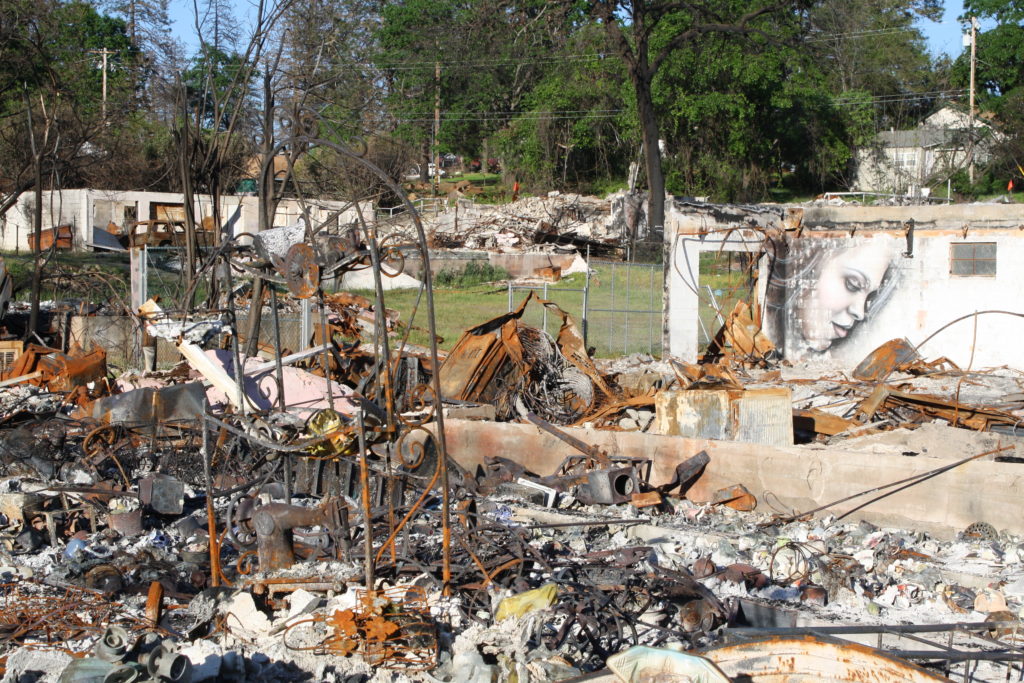The mural wasn’t a phenomenon right away. That first mural of a young woman’s face painted in black and white. It’s on the only remnants of the home of an old friend: their chimney. It was through Facebook that Shane Grammer’s mural became an international sensation. It was just a piece of art he did on his friend’s burned-out home, but it turned into something much larger than he could ever imagine.
“People were so devastated in that area that it was like it was some of the first beauty they’ve seen,” said Grammer, an artist from Los Angeles, but who grew up in Chico.
Looking was forward, Grammer wasn’t even aware that he would make multiple trips up to Paradise to create more than 10 murals in the community; memorials and pieces of hope for a community that didn’t have much to look forward to. A beacon of beauty in the burnout community that everyone was once able to call home.
Grammer grew up near the Paradise area, living in the neighboring, bigger community of Chico. The area was a place where he called home until he moved to Los Angeles for his career as an artist. But his home never left his thoughts and feelings, even when he saw what was happening to his friends and family during the Camp Fire.

It was through social media that he saw family and friends wearing masks, posting about their struggles and what was happening to them during the fires. After he made the eight-hour drive for the first time, he saw what was left of a community he once knew so well.
“There are sections of people who just didn’t have anything anymore.”
It was the first time Grammer had seen what had happened; what the fire had done to this world he knew. But over time, he would continue to come back to Paradise and to the area and hear the countless stories of what happened to those in the area.
Before his murals in Paradise, Grammer was creating murals around the globe, bringing attention to different, yet difficult topics. His first mural, when he was only 19, was for an orphanage in Mexico. But this wasn’t the end. He used his love of street art to raise awareness about important topics, especially sex trafficking.
But his murals had a different impact; a different appreciation to them before Paradise.
“For a lot of the heavy issues I do artwork for, a lot of people don’t care. Only the people who care about that issues are the ones who care.”
But Paradise was different.
“The art did move people and encouraged people. It gave them beauty.”
That first piece was what really allowed Grammer to gain the attention that launched him into a new realm of stardom. At first, he just shared his work to his Facebook page, just as he had done with so many other pieces that he had created throughout time.
It was only when his friend, the one he created the mural for, shared it to a Facebook page for survivors, that it really gained traction. People saw the art, the beauty of this one single painting.
This sparked a storm on social media. People were sharing the post. People were asking for their own murals to be painted. International media reached out to Grammer, asking for interviews and wondering about the piece he created.
As of now, Grammer has created over 15 murals in Paradise for the community. He has created memorials. He has created pieces for families who lost almost everything. Pieces for families who lost families. Pieces of hope. Pieces of strength.
Grammer said that much of the area, including his hometown of Chico, has always been a creative space for those who continue to make art, but he hopes that his work inspires others to turn to the arts, and maybe find a sense of healing through it.
“I hope this mural project encourages other creators to create and move people,” said Grammer.
Grammer prides himself on being a Christian, but overall, he seems to be proud to give something back to his community through the art form that he loves. Through his art, he’s been able to give back to his old community and to continue.
Because of his work and the attention it received, multiple fundraisers have been set up to raise money for different art programs in the area, including a program to help young people use art to heal from the disaster.
But Grammer never did this for the fame. He did this all to help a community that he still cares about, and to help a healing process in any way he can.
“I’ve done my job as a human.”